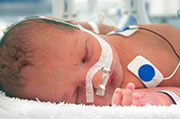- Double Mastectomy May Offer No Survival Benefit to Women With Breast Cancer
- Toxic Lead Found in Cinnamon Product, FDA Says
- Certain Abbott Blood Sugar Monitors May Give Incorrect Readings
- Athletes Can Expect High Ozone, Pollen Counts for Paris Olympics
- Fake Oxycontin Pills Widespread and Potentially Deadly: Report
- Shingles Vaccine Could Lower Dementia Risk
- Your Odds for Accidental Gun Death Rise Greatly in Certain States
- Kids From Poorer Families Less Likely to Survive Cancer
- Tough Workouts Won’t Trigger Cardiac Arrest in Folks With Long QT Syndrome
- At-Home Colon Cancer Test Can Save Lives
U.S. Preemie Birth Rate Continues to Fall: Report


FRIDAY, Nov. 1The preterm birth rate in the United States fell for a sixth consecutive year in 2012 — and that 11.5 percent rate is a 15-year low, a new report says.
Six states — Alaska, California, Maine, New Hampshire, Oregon and Vermont — earned an “A” on the March of Dimes’ annual premature birth report card because their preterm birth rates met the group’s 9.6 percent goal.
A premature birth is one that occurs before 37 weeks of pregnancy. Health consequences can include breathing problems, developmental delays and cerebral palsy. Prematurity is also a leading cause of newborn death.
Since 2006, about 176,000 fewer premature babies have been born in the United States, potentially saving the nation about $9 billion in health and societal costs, according to the report released Friday.
But even though last year’s U.S. preterm birth rate was the lowest since 1998, the nation again earned a “C” on the report card.
“Although we have made great progress in reducing our nation’s preterm birth rate from historic highs, the U.S. still has the highest rate of preterm birth of any industrialized country. We must continue to invest in premature birth prevention because every baby deserves a healthy start in life,” Dr. Jennifer Howse, president of the March of Dimes, said in a news release from the group.
“A premature birth costs businesses about 12 times as much as uncomplicated healthy birth. As a result, premature birth is a major driver of health insurance costs not only for employers,” she noted.
The preterm birth rate in the United States peaked in 2006 at 12.8 percent after climbing steadily for more than two decades, according to the U.S. National Center for Health Statistics. Almost all states had lower preterm birth rates in 2012 when compared to 2006.
Blacks had the highest preterm birth rate in 2012, at 16.5 percent. That was down from 18.5 percent in 2006 and was the lowest in more than 20 years. While the gap between blacks and whites has slowly narrowed, the preterm birth rate among blacks is still more than 1.5 times higher than among whites.
The report also assessed states’ progress in reducing risk factors for preterm birth and found the following:
- 37 states, the District of Columbia and Puerto Rico reduced the percentage of uninsured women of childbearing age.
- 35 states and the District of Columbia reduced the percentage of women of childbearing age who smoke.
- 28 states, the District of Columbia and Puerto Rico lowered the late preterm birth rate (infants born between 34 and 36 weeks gestation).
More information
The American Academy of Pediatrics outlines health issues faced by premature infants.
Source: HealthDay
Copyright © 2024 HealthDay. All rights reserved.










